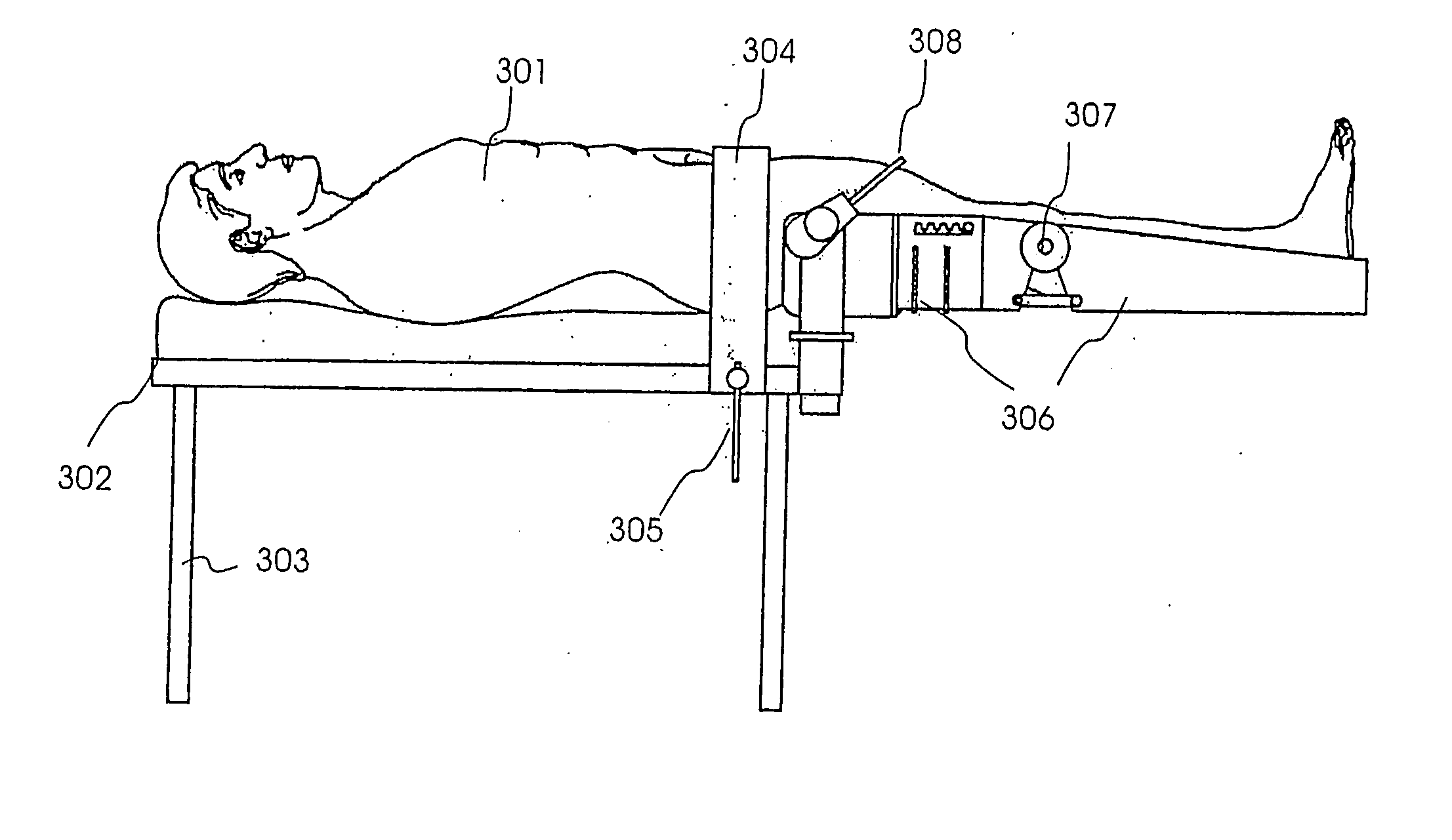Stretching apparatus
a technology for stretching muscles and muscles, applied in the field of stretching apparatuses, can solve the problems of undesirable strain of stretching muscles, inefficient energy consumption, arthritis and back pain, etc., and achieve the effect of increasing or maintaining the range of motion (rom) of the hip join
- Summary
- Abstract
- Description
- Claims
- Application Information
AI Technical Summary
Benefits of technology
Problems solved by technology
Method used
Image
Examples
first embodiment
[0082]FIG. 3 illustrates apparatus according to the present invention in use by a subject. The subject 301 is illustrated in resting supine position. The subject's head and upper body as far as the hips is supported on an examination table 302 typically comprising a padded couch to support the subject's back. The examination table is raised from a ground surface by one or a plurality of leg supports 303 which raise the examination table approximately 60-80 cm from the ground surface. The leg supports 303 are optionally adjustable to accommodate subject's of varying size. Two cradles 306, each configured to support one of the subject's legs extend from one end of the examination table. In supine position the subjects upper body and head are supported by the padded couch 302 and the subject's legs are located in cradles 306 and, in resting position, each cradle 306 extends in-line with the examination table so that the user is in a relaxed supine resting position. A pelvic clamp 305 f...
third embodiment
[0107] In the present invention, the examination table and stretching apparatus are located approximately 15-30 cm from a ground surface. Support means is provided to support at least one cradle in a position of 0° flexion. The support means comprises a support leg, provided on the underside of one or both of the first cradle sections which extends substantially transverse to the main under surface of the first cradle section towards a ground surface, contacting the ground surface and providing a support leg to support the subject's legs within the respective cradles. A roller or castor is provided at one end of the support leg configured to contact the ground surface. The support leg is provided in order to decrease the load on each of the ratchets of the cradle movement means which operate to maintain a selected position of each cradle through the first plane of movement. Each castor is configured to move across a ground surface such that abduction and adduction stretches can be p...
fourth embodiment
[0113] In other respects, the present invention is compatible with features of any previous embodiment of the present invention.
[0114] In a fifth specific embodiment, the stretching apparatus is located above a support bar. Referring to FIG. 15A herein, there is illustrated schematically an elevation view of a right hand limb cradle and chassis of the stretching apparatus in accordance with the fifth embodiment. The right hand limb cradle comprises a first cradle section 1501, a second cradle section 1502, and an arm 1503 attached to the second cradle section 1502. In the fifth embodiment the third cradle section is not required and is replaced by attachment using arm 1503 for connection to the cradle movement means 1507.
[0115] When the cradle is in a position of 0° flexion, the first cradle section 1501 is in contact at its lower surface with a support bar 1504. The support bar 1504 and the cradle movement means 1507 are located on a chassis 1505. A height of the support bar and a...
PUM
 Login to View More
Login to View More Abstract
Description
Claims
Application Information
 Login to View More
Login to View More - R&D
- Intellectual Property
- Life Sciences
- Materials
- Tech Scout
- Unparalleled Data Quality
- Higher Quality Content
- 60% Fewer Hallucinations
Browse by: Latest US Patents, China's latest patents, Technical Efficacy Thesaurus, Application Domain, Technology Topic, Popular Technical Reports.
© 2025 PatSnap. All rights reserved.Legal|Privacy policy|Modern Slavery Act Transparency Statement|Sitemap|About US| Contact US: help@patsnap.com



